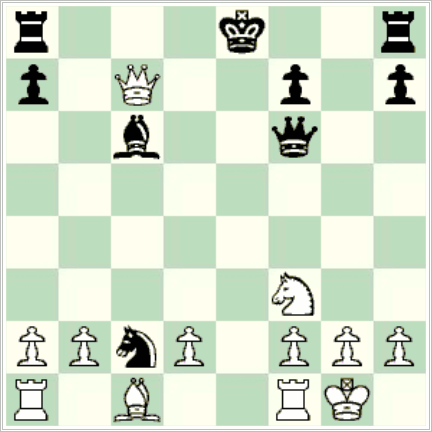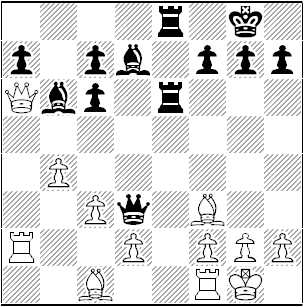Oliver Dunne sends in a highly unusual and interesting game from this year’s Branagan Cup:
 Carl Jackson – Oliver Dunne
Carl Jackson – Oliver Dunne
Branagan Cup 2012, round 1
Gonzaga-Elm Mount (5), 16 April 2012
1. e4 Nf6 2. Nc3 d5 3. exd5 Nxd5 4. Bc4 e6 5. Bxd5 exd5 6. Qe2+ Be7 7. Qe5 Nc6 8. Qxg7
A poisoned pawn …
8. … Bf6 9. Qh6 Bg5 10. Qh5 Nb4 11. Nf3 Bf6 12. O-O Nxc2 13. Nxd5 Be6 14. Nxf6+ Qxf6 15. Qb5+ Bd7 16. Qxb7
… and a second one. What is the record for number of poisoned pawns captured in a game? Tim Krabbé’s Chess Records page doesn’t have a category for this.
16. … Bc6 17. Qxc7 (diagram)
Now Oliver played the amazing 17. … Qxf3!!??. Of course White loses immediately if he captures, while if he checks first Black gets rook, bishop knight and pawn for the queen. Still, it’s a highly speculative trade, given the disjointed arrangement of the black pieces. Is it quite sound? No, say the engines, but it’s not necessarily easy to find an answer over the board, and White goes wrong. He resigns just as he is about to be mated in the middle of the board. And very picturesquely mated too: after 29. Kd5 Rd8 mate (or 29. f4 Rxf4+ 30. Kd5 Rd8 mate), all eight squares around the white king are empty, and five black pieces combine to cover all escapes.
18. Re1+ Nxe1 19. gxf3 Nxf3+ 20. Kf1 Bb5+ 21. Kg2 Ne1+ 22. Kg3 Rg8+ 23. Kf4 Nd3+ 24. Ke3 Kf8 25. b3 Re8+ 26. Kd4 Kg7 27. Qc3 Kh6 28. Bb2 Rg4+ 0-1.
[Click to replay the full game.]
Zygimantas Jakubauskas, also of Elm Mount, pointed out a similarity with a celebrated game of Morphy, as Black against Paulsen in the First American Congress in 1857:
 Here Morphy played 17. … Qxf3!!, winning in all variations. The conclusion was 18. gxf3 Rg6+ 19. Kh1 Bh3 20. Rd1 Bg2+ 21. Kg1 Bxf3+ 22. Kf1 Bg2+ 23. Kg1 Bh3+ 24. Kh1 Bxf2 25. Qf1 Bxf1 26. Rxf1 Re2 27. Ra1 Rh6 28. d4 Be3 0-1.
Here Morphy played 17. … Qxf3!!, winning in all variations. The conclusion was 18. gxf3 Rg6+ 19. Kh1 Bh3 20. Rd1 Bg2+ 21. Kg1 Bxf3+ 22. Kf1 Bg2+ 23. Kg1 Bh3+ 24. Kh1 Bxf2 25. Qf1 Bxf1 26. Rxf1 Re2 27. Ra1 Rh6 28. d4 Be3 0-1.
Though there were minor inaccuracies in the finish, the sacrifice is sound in this case. (Click to replay the full game (external database).)
This game has been a staple of anthologies ever since. It can be found, for example, in Reuben Fine’s The World’s Great Chess Games, 2nd ed. (New York: David McKay, 1976), pp. 23-24 (‘one of his most brilliant efforts’). (Fine’s book is available in Google Books.)
So in both games we have queen takes bishop minor piece on f3, in front of White’s unbroken castled K-side, on move 17 in each case.
Here’s a final question: in Jackson-Dunne the sacrifice, while artistically by far the best choice, isn’t objectively correct. So (without consulting engines) what should Black have played in the first diagrammed position above?

Pingback: Another queen sacrifice | IRLchess
A somewhat similar final mating position occurred in the Asian Continental Championships (Women’s Section; 2015) in the round 3 game between Atousa Purkashiyan vs Padmini Rout. In the position where White’s pieces occupied the following squares: Bc6, Rd2, Rf5, Qh6, Kh2, Pb3, Pc2, Pf2, Pg3 and Ph3; and Black’s: Qa7, Rc7, Ke7, Bc5, Rc3, Pb4, Pe3 and Pf7…. White played 41. Re5# – where four pieces play a role and the king is in the middle of the board. Black’s king is also blocked by his own pawn on f7 however.
Erratum: I should have said ‘her own pawn on f7’.